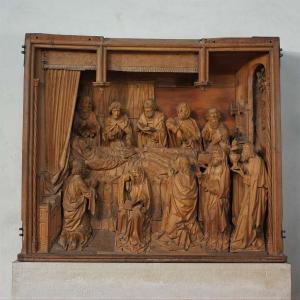
Mary, like all of us, is a created being. She is “of earth,” like the rest of humanity. Similarly, like us, there was a time in which she went “back to the earth,” that is, there was a time when she died and was placed in a tomb. “She was earth by her mortality and she went into the earth by her death.” [1] Yes, Mary is the Mother of God; she gave birth to the one who came from above, giving her a special, indeed, unique relationship with God, one which is worthy of honor and praise. Nonetheless, she was human, all too human, and we must not forget that either. She lived out a human life, a temporal existence which, however intertwined it was with grace, meant that it would, and did, come to a temporal end, one which included a very human death. She died, sharing in the fate of all humanity. And, as is the case of every death, as every person is unique, her death was experienced in a unique way; she knew when it was her time, and she prepared the faithful by having them come together one last time with her, so that they would then be ready for it. She represented the perfection of humanity in her treatment of death, and so she treated it full of dignity and honor, embracing it as a part of normal human existence. It was her acceptance of it which enabled her to be glorified in and through it, which is what is remembered when we discuss her assumption into heaven. She died, was buried, and then found herself participating in eternity, in eternal life, experiencing the resurrection of the dead for herself, partaking of all the glory which is to be found in the eschatological resurrection from the dead. Her body was “assumed into heaven” that is, was fully taken into the eschaton; one day, we will follow her and participate in the eschatological resurrection and hopefully be glorified like her. “The presence of the Mother of God in heaven corresponds to Her perfect sanctification and deification, in which She will be followed by humankind in the glorified Church.” [2] Her death was a human death, her glorification a human glorification, even if it was a special representation of that glorification because of her role in salvation history.
Mary presents us the perfection of humanity, of the way humanity can and should give itself over completely to God, and she did this by answering yes to all that God asked of her. God then took that yes, and all that was contained in and with it, and used it as the seed for the incarnation. God took it and assumed it personally in the person of the Logos, and then the Logos, as man, became one of us, which is why the Logos, Jesus, is the personal mediator between God and humanity. And yet, because she rendered herself over to God with a perfect yes to God, she can be seen as the one who mediates humanity to God, as the one who gave it over to God on behalf of us all, allowing the one who is beyond space and time to take space with humanity even as the Logos took up space in her womb.
Mary lived her life with humility, which is the only way perfection can be found. It was that humility which let her give herself over to God at the annunciation. It was allowed her to continue to give her whole self to God throughout all her life. It was let her surrender herself to God at death, making it the perfect ending of her life. She gave herself over to God with complete trust, and God fulfilled that trust in her translation from her temporal existence into eternity.
Life outside of eternity is always transitory; it is always giving way to death, as every moment dies to give birth to a new one. Every moment gives us a sign of the resurrection to come. We can try to fight and resist it, to become so attached to the past, making our present a living death, or we can give ourselves over to the moment, accepting our share of temporal existence, our new life. We dream of life without death, that is, eternal life. Mary shows us it is possible. Our temporal death, the end of our temporal existence, has become the gate to eternity, thanks to the death and resurrection of Jesus. Mary has been given the special privilege to experience and represent that translation for us, to show us that we have hope for life beyond death. We have a sign of that hope given to us by the translation of her body. She is no longer among the dead. She is truly glorified, experiencing in and with her body, the spiritualization of the body which takes place at the eschatological resurrection from the dead. Her body may no longer here with us, in a temporal sense, but she is now present with us, in the way all who enter into eternity find they have a special presence in all time (and space) (for eternity includes all that is temporal as a part of what it is).
Mary is blessed, but she is blessed not just because of her origin, but also because of her end and all that she did in between. She could have, in a way, fallen; she should have said no to God. But when the Word of God came to her, she said yes. Her yes was not just for herself, but for all humanity. She is blessed because she listened to and followed the Word of God (cf. Lk. 11:28). She accepted her death when its time came; she did not struggle against it. Even in that moment, she gave her yes to God, so that she truly could and would find herself fully taken in by God. Just as her yes to the Word led to the incarnation, her yes at death, in a way, is spoken for all humanity, so that all humanity can follow her and be taken in by God. We are not to seize and grasp after glory, but rather, we are to give ourselves over to God; when we do that, we will have learned the value of humility. We will understand true glory is only found in willful and true humility. This is what her life and death shows, confirming the pattern established by Jesus was not just for Jesus but for all humanity:
Have this mind among yourselves, which was in Christ Jesus, who, though he was in the form of God, did not count equality with God a thing to be grasped, but emptied himself, taking the form of a servant, being born in the likeness of men. And being found in human form he humbled himself and became obedient unto death, even death on a cross. Therefore God has highly exalted him and bestowed on him the name which is above every name, that at the name of Jesus every knee should bow, in heaven and on earth and under the earth, and every tongue confess that Jesus Christ is Lord, to the glory of God the Father (Philip. 2:2-11).
From the first to the last moment of her earthly existence, Mary lived the path of self-emptying love, the path of humility, and through it she was led to the glorification not only of her humanity, but of all humanity, at her death. Jesus will not by the one to experience the resurrection from the dead. We are to keep in mind the way of Christ so we can imitate him and receive in and through him the glorification of humanity. We have Mary showing us this is possible. We must learn to trust in God, to say yes to God, so that then we can, like Mary, rest in that trust and hope that our yes will lead us to our own glorification.
[1] Richard of St Victor, “On Emmanuel,” in Interpretation of Scripture: Practice. Trans. Frans van Liere. Ed. Frans van Leiere and Franklin T. Harkins (Turnhout, Belgium: Brepols, 2015), 431. [About the Theotokos].
[2] Sergius Bulgakov, The Bride of the Lamb. Trans. Boris Jakim (Grand Rapids, MI: William B. Eerdmans Publishing Company, 2002), 412.
Stay in touch! Like A Little Bit of Nothing on Facebook.
If you liked what you read, please consider sharing it with your friends and family!
N.B.: While I read comments to moderate them, I rarely respond to them. If I don’t respond to your comment directly, don’t assume I am unthankful for it. I appreciate it. But I want readers to feel free to ask questions, and hopefully, dialogue with each other. I have shared what I wanted to say, though some responses will get a brief reply by me, or, if I find it interesting and something I can engage fully, as the foundation for another post. I have had many posts inspired or improved upon thanks to my readers.













